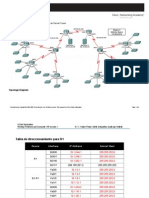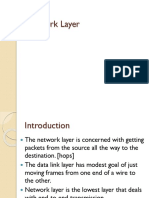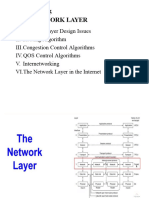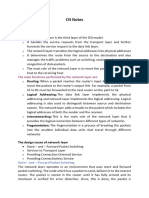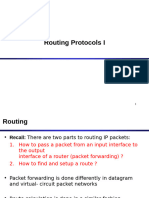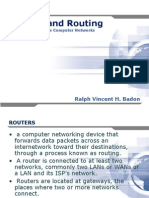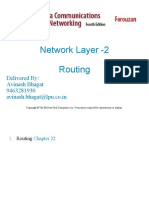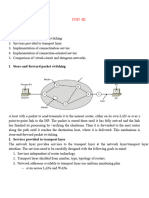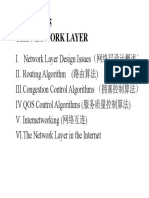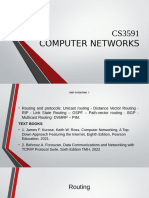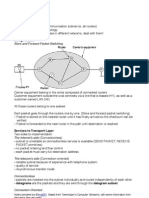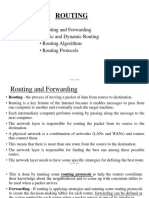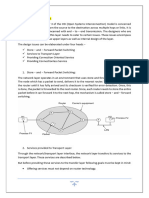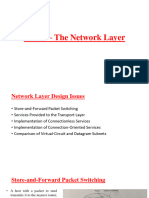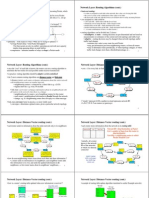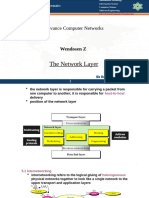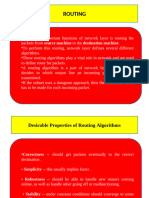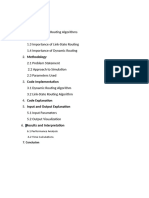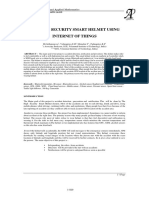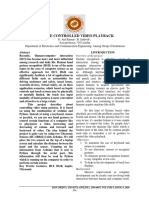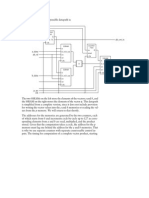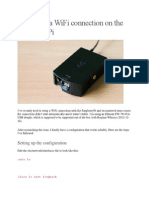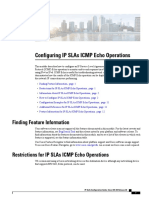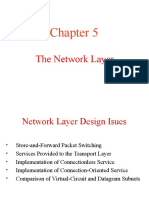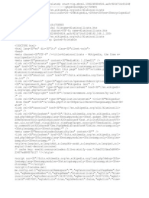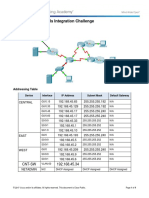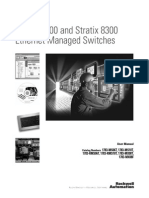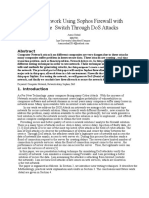07 Network Layer Print PDF
07 Network Layer Print PDF
Uploaded by
Matthew BattleCopyright:
Available Formats
07 Network Layer Print PDF
07 Network Layer Print PDF
Uploaded by
Matthew BattleOriginal Title
Copyright
Available Formats
Share this document
Did you find this document useful?
Is this content inappropriate?
Copyright:
Available Formats
07 Network Layer Print PDF
07 Network Layer Print PDF
Uploaded by
Matthew BattleCopyright:
Available Formats
7.
Network Layer
The Network Layer is responsible for getting packets from source to
destination, possibly over multiple links
z Primary functions include:
Routing
Congestion Control
Internetwork data exchange
Provision of quality of service (QoS)
z We will concentrate on the issue of routing at the moment.
z The other issues of the network layer will be addressed in context of the Internet
The Transport Layer is responsible for end-to-end data transport
z Primary functions include:
Provision of connection oriented or connectionless service
Disassembling and reassembling data
Setup and release of connections across the network
z Some transport layer functions will be addressed in the Internet section
EE210 Data Communications and Computer Networks
1
Recall the OSI Model
EE210 Data Communications and Computer Networks
2
Network Layer: Routing Algorithms
routing algorithm = used by a router to decide on which output link each incoming
Packet will be transmitted
datagram packet-switching: this decision must be made for every Packet
virtual circuit packet-switching: routing decisions made only at v.c. set-up
desirable properties of a routing algorithm:
correctness, simplicity, efficiency obviously
robustness since usually the entire network cant be re-booted !!!
stability routing algorithm reaches equilibrium in a reasonable time
fairness, optimality
often in conflict, e.g.
link capacities
fully utilised by
A-A, B-B, C-C
traffic respectively
optimality with respect to what? What are we trying to optimise?!
average Packet delay? total Packet throughput?
these goals are often in conflict: operating any network near capacity
implies long queueing delays in node buffers
compromise minimise number of relays (or hops) a Packet needs
EE210 Data Communications and Computer Networks
3
Network Layer: Routing Algorithms (cont.)
least-cost routing:
a value is assigned to each link in the network: this is the cost of using this link
the cost of a route is the combination of the values of its links
the best route is the one with the lowest cost know how to relay incoming Packets
cost assigned to a link could be:
1 for each link finds route with the fewest hops
(financial) cost of using the link finds cheapest route
packet delay on the link finds minimum-delay route
packet transmission time on the link finds maximum-bandwidth route
or some combination of these, or other factors !
routing algorithms can be divided into 2 classes:
nonadaptive, or static routing decisions are pre-determined and not based on
measurements (or estimates) of the current network topology and traffic load
adaptive routing decisions may be changed when network topology and/or
traffic load changes
extreme case: select a new route for each Packet
may get information just from neighbouring routers, or from all routers
may re-determine routes periodically, or when topology changes, or when
traffic load changes more than a threshold percentage, or
EE210 Data Communications and Computer Networks
4
Network Layer: Routing Algorithms (cont.)
once the cost of each link is known, the routers can run a routing algorithm to
determine the best routes for each possible sender-receiver transmission
in practice: routing algorithm should be adaptive and de-centralised
The most common routing algorithms are distance-vector and link-state
distance-vector: each router exchanges information about the entire network
with neighbouring routers at regular intervals
neighbouring routers = connected by a direct link (e.g. a LAN)
regular intervals: e.g. every 30 seconds
link-state: each router exchanges information about its neighbourhood with
all routers in the network when there is a change
neighbourhood of a router = set of neighbour routers for this router
each routers neighbourhood information is flooded through the network
change: e.g. if a neighbouring router does not reply to a status message
as link-state converges faster, in practice is more widely used
converges = determines optimal routes, given a particular network topology
EE210 Data Communications and Computer Networks
5
Network Layer: Distance-Vector routing
cost = 1 for every link finds minimum-hop routes
clouds represent LANs; number in cloud represents network ID
A, B, C, D, E, F are routers (or gateways)
EE210 Data Communications and Computer Networks
6
Network Layer: Distance-Vector routing (cont.)
each router sends its information about the entire network only to its neighbours
how do non-neighbouring routers learn about each other and share information?
a router sends its information to its neighbours
each neighbour router adds this information to its own, and sends the updated
information to its neighbours; the first router learns about its neighbours neighbours
EE210 Data Communications and Computer Networks
7
Network Layer: Distance-Vector routing (cont.)
each router stores information about the network in its routing table
Network ID = final destination of Packet
Cost = number of hops from this router to
final destination
Next Hop = neighbouring router to which
Packet should be sent
initially, all a router
knows is the network
IDs of the networks
to which it is directly
connected
initial routing
table exchanges
(no multi-hop
routes yet)
EE210 Data Communications and Computer Networks
8
Network Layer: Distance-Vector routing (cont.)
how is a routers routing table updated when new information is received?
keep the entry
with lowest cost
as B is 1 hop
from A
routing table update algorithm (distributed Bellman-Ford algorithm):
add 1 to cost of each incoming route (since each neighbour is 1 hop away)
if a new destination is learned, add its information to the routing table
if new information received on an existing destination:
if Next Hop field is the same, replace existing entry with the new
information even if the cost is greater (new information invalidates old)
if Next Hop field is not the same, only replace existing entry with the
new information if the cost is lower
EE210 Data Communications and Computer Networks
9
Network Layer: Distance-Vector routing (cont.)
example of routing table update algorithm (unrelated to earlier Example network):
EE210 Data Communications and Computer Networks
10
Network Layer: Distance-Vector routing (cont.)
final (converged) routing tables for earlier Example network:
Note: choice between
equal-cost routes
depends on exact
sequence of updates
EE210 Data Communications and Computer Networks
11
Network Layer: Distance-Vector routing in practice
original ARPANET (forerunner of the Internet) used distance-vector routing
subsequently used in the Internet as RIP (Routing Information Protocol)
a variation of distance-vector routing is used in BGP (Border Gateway
Protocol), which finds routes from one autonomous system (AS) to another AS
AS = a part of the Internet (e.g. a network) managed by one entity
link cost can be something other than 1 for each link
e.g. packet delay, number of packets queued,
problem with distance-vector routing: count-to-infinity problem
this refers to the slow convergence of distance-vector routing algorithms
under some conditions
basic flaw slow reaction to link/router failure because information only
comes from neighbouring routers and it may be out-of-date (e.g. it may not
properly reflect the impact of the failure on route costs)
many ad-hoc solutions have been tried (e.g. split horizon), but either they
also fail to solve the count-to-infinity problem, or they are hard to implement
this slow convergence was one of the main reasons why other types of
routing algorithm were explored, leading to link-state routing
EE210 Data Communications and Computer Networks
12
Network Layer: Link-State routing
each router sends information about its neighbourhood to every other router:
EE210 Data Communications and Computer Networks
13
Network Layer: Link-State routing (cont.)
link cost is usually a weighted sum of various factors
e.g. traffic level, security level, packet delay,
link cost is from a router to the network connecting it to another router
when a packet is in a LAN (which is typically a broadcast network), every
node including the router can receive it no cost assigned when going
from a network to a router
Note: costs shown
are examples only
EE210 Data Communications and Computer Networks
14
Network Layer: Link-State routing (cont.)
routers share information by advertising, which means sending link-state packets
Advertiser: ID of sending router
Network: ID of destination network
Cost: link cost to neighbour
Neighbour: ID of neighbour router
a router gets its information about its neighbourhood by sending short ECHO
packets to its neighbours and monitoring the responses
the Figure shows
how router As
link-state packet
is flooded to all
other routers
EE210 Data Communications and Computer Networks
15
Network Layer: Link-State routing (cont.)
every router builds a link-state packet and floods it through the network, so when
all such packets have been received at a router, it can build its link-state database:
Assuming that every router
receives the same set of
link-state packets (as if the
routers were synchronised),
every router builds the same
link-state database.
Using this database, each
router can then calculate
its routing table.
EE210 Data Communications and Computer Networks
16
Network Layer: Link-State routing (cont.)
to calculate its routing table, a router uses Dijkstras Shortest-Path algorithm
first, identify all link costs in the network: either from the link-state database,
or using the fact that the cost of any link from a network to a router is 0
EE210 Data Communications and Computer Networks
17
Network Layer: Link-State routing Dijkstras algorithm
this algorithm builds a shortest-path spanning tree for the router: such a tree has a
route to all possible destinations, and no loops
the router running the algorithm is the root of its shortest-path spanning tree
even if all routers link-state databases are identical, the trees determined by
the routers are different (since the root of each tree is different)
a node is either a network or a router; nodes are connected by arcs
the algorithm keeps track of 2 sets of nodes and arcs Temporary and Permanent
initially, the Temporary set contains all neighbour nodes of the router itself,
and the arcs connecting them to the router; only the router is initially Permanent
when all nodes and arcs are in the Permanent set, the algorithm has terminated
identify the Temporary node whose arc has the lowest cumulative cost from the root:
this node and arc are moved into the Permanent set;
any nodes which are connected to the new Permanent node and are not already in the
Temporary set, along with the connecting arcs, are made Temporary. Also, if any node
already in the Temporary set has a lower cumulative cost from the root by using a route
passing through the new Permanent node, then this new route replaces the existing one;
repeat until all nodes and arcs are Permanent.
EE210 Data Communications and Computer Networks
18
Network Layer: Link-State routing Dijkstras algorithm (cont.)
as an Example, lets follow the steps of the algorithm run by router A
1.
2.
3.
Note: arcs are
marked with their
cumulative cost
from the root (not
individual costs)
EE210 Data Communications and Computer Networks
19
Network Layer: Link-State routing Dijkstras algorithm (cont.)
4.
Note: arcs are
marked with their
cumulative cost
from the root (not
individual costs)
5.
Note: equal cumulative costs
choose one arbitrarily in step 6
EE210 Data Communications and Computer Networks
20
Network Layer: Link-State routing Dijkstras algorithm (cont.)
6.
Note: arcs are
marked with their
cumulative cost
from the root (not
individual costs)
7.
EE210 Data Communications and Computer Networks
21
Network Layer: Link-State routing Dijkstras algorithm (cont.)
8.
Note: arcs are
marked with their
cumulative cost
from the root (not
individual costs)
9.
EE210 Data Communications and Computer Networks
22
Network Layer: Link-State routing Dijkstras algorithm (cont.)
10.
Note: arcs are
marked with their
cumulative cost
from the root (not
individual costs)
11.
if the new arc to network 66 from
router D had a lower cumulative cost
than the one from router C, then
the new link would replace the old one
EE210 Data Communications and Computer Networks
23
Network Layer: Link-State routing Dijkstras algorithm (cont.)
12.
Note: arcs are
marked with their
cumulative cost
from the root (not
individual costs)
13.
all nodes and arcs are
Permanent STOP:
this routers shortest-path
spanning tree has been found
EE210 Data Communications and Computer Networks
24
Network Layer: Link-State routing routing table
once a router has found its shortest-path spanning tree, it can build its routing table
to complete the Example, here is router As link-state routing table:
Note: each routers routing table
will (in general) be different
Networks 14, 23, and 78 dont have
a Next router entry because they
are directly connected to this router
in large networks, the memory required to store the link-state database and the
computation time to calculate the link-state routing table can be significant
in practice, since the link-state packet receptions are not synchronised, routers may
be using different link-state databases to build their routing tables: how inaccurate
the results are depends on how different the routers views of the network are
EE210 Data Communications and Computer Networks
25
Network Layer: Link-State routing in practice
link-state routing algorithms have several desirable properties, e.g. rapid convergence; small
amount of traffic generated; rapid response to topology changes
examples from the Internet are the Open Shortest Path First (OSPF) and Intermediate
System to Intermediate System (IS-IS) routing protocols
link costs can be configured in OSPF. Possible link costs include:
1 for each link
reliability: assigned by administrator, indicates how often the link fails
packet delay
link bandwidth
financial cost of the link
OSPF requires a lot of memory: each router holds its routing table & link-state database
Dijkstras algorithm computations are processor-intensive
legacy routers may be unable to relay packets when these calculations are taking
place which could be every time a link-state packet is received
OSPF can consume a lot of bandwidth if the network topology changes often
link-state packets sent to all routers using reliable flooding
need sequence number and time-to-live (TTL) field in each packet
EE210 Data Communications and Computer Networks
26
You might also like
- BlokadaDocument250 pagesBlokadaIsmael HenriqueNo ratings yet
- Cap. 5: Reto de Integración de Habilidades de Packet Tracer: Topology DiagramDocument6 pagesCap. 5: Reto de Integración de Habilidades de Packet Tracer: Topology DiagramJose rodriguezNo ratings yet
- NetworkLayer RoutingDocument64 pagesNetworkLayer RoutingRishiGuptaNo ratings yet
- Chapter 4 - Routing and Routing ProtocolsDocument41 pagesChapter 4 - Routing and Routing Protocolstesfahuntilahun44No ratings yet
- The Network Layer Is Concerned With GettingDocument103 pagesThe Network Layer Is Concerned With GettingsrinusirisalaNo ratings yet
- Networking and Internetworking DevicesDocument58 pagesNetworking and Internetworking DevicesRaj ChauhanNo ratings yet
- Network Layer: Delivery, Forwarding, and RoutingDocument62 pagesNetwork Layer: Delivery, Forwarding, and RoutingAarti KhareNo ratings yet
- Chapter IIIDocument25 pagesChapter IIImulusew atenafuNo ratings yet
- Part 3-Network LayerDocument63 pagesPart 3-Network LayerLohith Reddy ANo ratings yet
- Unit 4 Network LayerDocument43 pagesUnit 4 Network LayerRahul ChugwaniNo ratings yet
- Module-3 PPTDocument163 pagesModule-3 PPTvinutha kNo ratings yet
- CN4 NOTES Converted 796c356e 4937 4d06 Ba7e C8c2a69b7aecDocument67 pagesCN4 NOTES Converted 796c356e 4937 4d06 Ba7e C8c2a69b7aecgeetabenmavani03No ratings yet
- CS 408 Computer Networks: Chapter 11: Routing in IPDocument54 pagesCS 408 Computer Networks: Chapter 11: Routing in IPThuu Wien Tya EwieNo ratings yet
- CN Unit-5 MaterialDocument21 pagesCN Unit-5 Materialabinayaa.sNo ratings yet
- Chap-3-Routing-Distance Vector - Link StateDocument48 pagesChap-3-Routing-Distance Vector - Link Statemadhurcb1No ratings yet
- Unit 5Document114 pagesUnit 5Aryan SinghNo ratings yet
- Cs3591-Unit 4Document19 pagesCs3591-Unit 4reshma.rNo ratings yet
- Network LayerDocument66 pagesNetwork LayerEatus AspiritusNo ratings yet
- Cs3591 CN Unit 4 NotesDocument19 pagesCs3591 CN Unit 4 NotesramyadeviNo ratings yet
- Routers and Routing: Ralph Vincent H. BadonDocument41 pagesRouters and Routing: Ralph Vincent H. BadonJanus Cesar Ruizan QuilenderinoNo ratings yet
- Unit 4Document12 pagesUnit 4Pon MuruganNo ratings yet
- NetworkLayer RoutingDocument64 pagesNetworkLayer RoutingDrashtiNo ratings yet
- Unit 53Document114 pagesUnit 53HASAN KAMRAN (RA2011033010059)No ratings yet
- Routing For BCADocument35 pagesRouting For BCAPratibhaNo ratings yet
- Unit 3Document31 pagesUnit 320H51A04P3-PEDAPUDI SHAKTHI GANESH B.Tech ECE (2020-24)No ratings yet
- Unit-3 CNDocument11 pagesUnit-3 CNtanveerpal2002No ratings yet
- 4th UnitDocument60 pages4th UnitManohar ManuNo ratings yet
- Lec5 WWW Cs Sjtu Edu CNDocument155 pagesLec5 WWW Cs Sjtu Edu CNAUSTIN ALTONNo ratings yet
- UNIT-IV PPT (2)Document47 pagesUNIT-IV PPT (2)Abinaya BabuNo ratings yet
- Store and Forward Packet SwitchingDocument22 pagesStore and Forward Packet SwitchingKevin PanuelosNo ratings yet
- Static Vs Dynamic: Routing AlgorithmDocument10 pagesStatic Vs Dynamic: Routing AlgorithmAnjuPandeyNo ratings yet
- Network LayerDocument18 pagesNetwork LayerChamara PrasannaNo ratings yet
- Lecture #5 THRDocument45 pagesLecture #5 THRZainab ShahzadNo ratings yet
- COMPUTER NETWORKS NOTES (1) Design Issues...Document20 pagesCOMPUTER NETWORKS NOTES (1) Design Issues...kevinjumaochiengNo ratings yet
- 4 ModuleDocument71 pages4 ModuleKrishnakumar KattarakunnuNo ratings yet
- UNIT-4: The Network LayerDocument83 pagesUNIT-4: The Network LayerNAMAN JAISWALNo ratings yet
- Cs3591 CN Unit 4 Notes EduenggDocument21 pagesCs3591 CN Unit 4 Notes Eduenggvijrj29No ratings yet
- What Is Routing AlgorithmDocument12 pagesWhat Is Routing AlgorithmTum BinNo ratings yet
- RoutingDocument22 pagesRoutingisratjahanchandmoniNo ratings yet
- COMPUTER NETWORKS Unit-3 NotesDocument23 pagesCOMPUTER NETWORKS Unit-3 NotesyashhardasaniNo ratings yet
- CN UNIT 4Document22 pagesCN UNIT 4dd7183382No ratings yet
- Unit 2 Network LayerDocument94 pagesUnit 2 Network LayerRamana KadiyalaNo ratings yet
- Routing in Communications NetworksDocument74 pagesRouting in Communications NetworksSandeep VermaNo ratings yet
- FON Unit III - IoTDocument27 pagesFON Unit III - IoTtejaswi231008No ratings yet
- Unit 3Document27 pagesUnit 3Govardhan KonukatiNo ratings yet
- Unit 5Document31 pagesUnit 5dhruv shahNo ratings yet
- CN Unit 2 SlidesDocument72 pagesCN Unit 2 SlidesPallavi K PyatiNo ratings yet
- CNDocument13 pagesCNsuryamadhuchandran007No ratings yet
- 3_networkingDocument101 pages3_networkingSameerNo ratings yet
- UNIT-III Network LayerDocument118 pagesUNIT-III Network LayerSARKARI BABUNo ratings yet
- Network Layer: Routing Algorithms Network Layer: Routing Algorithms (Cont.)Document6 pagesNetwork Layer: Routing Algorithms Network Layer: Routing Algorithms (Cont.)Makarand ShiriskarNo ratings yet
- Presentation 4Document99 pagesPresentation 4Tegbaru TameneNo ratings yet
- 4-7 Network LayerDocument109 pages4-7 Network LayerTutun JuhanaNo ratings yet
- Lecture Notes 5 - RoutingDocument7 pagesLecture Notes 5 - Routingchinnianu668No ratings yet
- Unit 5Document83 pagesUnit 5alain.aliasNo ratings yet
- 5 - Network Layer Control PlaneDocument13 pages5 - Network Layer Control Planeep21b004No ratings yet
- Dynamic Routing Protocols I RIP: Relates To Lab 4Document36 pagesDynamic Routing Protocols I RIP: Relates To Lab 4DarwinNo ratings yet
- Module10 Rip PDFDocument18 pagesModule10 Rip PDFEmmanuel AduKissieduNo ratings yet
- CNM Chapter5Document18 pagesCNM Chapter5saadmulla1717No ratings yet
- Unit 3Document54 pagesUnit 3sakshamsharma7257No ratings yet
- cn_routingalgorithmsDocument18 pagescn_routingalgorithmslioncheppusalamrankuNo ratings yet
- Lecture: Cache Hierarchies: Topics: Cache Innovations (Sections B.1-B.3, 2.1)Document20 pagesLecture: Cache Hierarchies: Topics: Cache Innovations (Sections B.1-B.3, 2.1)Matthew BattleNo ratings yet
- Yusong Guo, Zhen Yu and Weimei ZhaoDocument6 pagesYusong Guo, Zhen Yu and Weimei ZhaoMatthew BattleNo ratings yet
- The High Security Smart Helmet Using Internet of Things: AbstractDocument12 pagesThe High Security Smart Helmet Using Internet of Things: AbstractMatthew BattleNo ratings yet
- Gesture Controlled Video Playback: Overview of The ProjectDocument4 pagesGesture Controlled Video Playback: Overview of The ProjectMatthew BattleNo ratings yet
- Timer Counter in ARM7 (LPC2148) : Aarav SoniDocument26 pagesTimer Counter in ARM7 (LPC2148) : Aarav SoniMatthew BattleNo ratings yet
- Timer Counter in ARM7 (LPC2148) : Aarav SoniDocument26 pagesTimer Counter in ARM7 (LPC2148) : Aarav SoniMatthew BattleNo ratings yet
- ICT Applications For Environmental Management in Korea: Park, Sang HyunDocument24 pagesICT Applications For Environmental Management in Korea: Park, Sang HyunMatthew BattleNo ratings yet
- Logic DesignDocument2 pagesLogic DesignMatthew BattleNo ratings yet
- P - CNT - Ce CNT - RST: Counter 7-Bit Ce Reset Q TC CLK Counter 7-Bit Ce Reset QDocument7 pagesP - CNT - Ce CNT - RST: Counter 7-Bit Ce Reset Q TC CLK Counter 7-Bit Ce Reset QMatthew BattleNo ratings yet
- A Ac Ca Ad de em Mi Ic C R Re Es Se Ea Ar RC CH H D Di IV VI Is Si Io On NDocument1 pageA Ac Ca Ad de em Mi Ic C R Re Es Se Ea Ar RC CH H D Di IV VI Is Si Io On NMatthew BattleNo ratings yet
- Technological Improvement in Medical Field Using FinalDocument4 pagesTechnological Improvement in Medical Field Using FinalMatthew BattleNo ratings yet
- ITP310 Networking 2Document9 pagesITP310 Networking 2Rowena ReyesNo ratings yet
- Ip AddressingDocument83 pagesIp AddressingGetnete degemuNo ratings yet
- Cobox-E1m t1mDocument45 pagesCobox-E1m t1mNageswar MakalaNo ratings yet
- ALU10KDocument59 pagesALU10KZinko ThuNo ratings yet
- 1Document7 pages1cahyoNo ratings yet
- Setting Up A WiFi Connection On The RaspberryPiDocument11 pagesSetting Up A WiFi Connection On The RaspberryPiTry FajarmanNo ratings yet
- DS-2CD1723G0-I (Z) 2.0 MP VF Network Bullet Camera: Key FeaturesDocument4 pagesDS-2CD1723G0-I (Z) 2.0 MP VF Network Bullet Camera: Key FeaturesCarlos TrianaNo ratings yet
- Sla Icmp EchoDocument14 pagesSla Icmp EchoFeleke AfeworkNo ratings yet
- 3 NetworkLayer Part1.ppt - 0Document63 pages3 NetworkLayer Part1.ppt - 0Anonymous pEjvosqNo ratings yet
- Aluminosilicate - Wikipedia, The Free EncyclopediaDocument80 pagesAluminosilicate - Wikipedia, The Free Encyclopediaresearcher911No ratings yet
- Mini-Lab - Student GuideDocument14 pagesMini-Lab - Student GuideDiego Fernando Solis H100% (1)
- Mixed-Port - 789-WPS OfficeDocument23 pagesMixed-Port - 789-WPS OfficeVũ Đằng Minh AnNo ratings yet
- ERouting OSPF PT Practice SBADocument4 pagesERouting OSPF PT Practice SBAJavier FloresNo ratings yet
- Dell EMC VxRail - VCF On VxRail - How To Re-Generate TLS Certificate For VxRail Manager - Dell USDocument11 pagesDell EMC VxRail - VCF On VxRail - How To Re-Generate TLS Certificate For VxRail Manager - Dell US604597No ratings yet
- Routing Protocol and Routed Protocol: Lab #5 IP Routing IDocument8 pagesRouting Protocol and Routed Protocol: Lab #5 IP Routing IMahfuzur RahmanNo ratings yet
- 1.3.1.3 Packet Tracer - Skills Integration ChallengeDocument4 pages1.3.1.3 Packet Tracer - Skills Integration ChallengeBryan GualotoNo ratings yet
- Poly vvx-450 DatasheetDocument3 pagesPoly vvx-450 Datasheetdbull108No ratings yet
- FaqDocument205 pagesFaqAndrea FloriNo ratings yet
- Cisco Hierarchical Color Aware PolicingDocument14 pagesCisco Hierarchical Color Aware PolicinghelbakouryNo ratings yet
- Stratix 8000-Express Setup PDFDocument7 pagesStratix 8000-Express Setup PDFDavidSVNo ratings yet
- Recovery Behavior of Communication Manager From Control Network OutagesDocument11 pagesRecovery Behavior of Communication Manager From Control Network OutagesTaro YamadaNo ratings yet
- Netsh Int TCP Show GlobalDocument1 pageNetsh Int TCP Show GlobalashokjpNo ratings yet
- ComWare Device Hardening TemplateDocument3 pagesComWare Device Hardening Templateblack_sparrowNo ratings yet
- Testing of Network Using Sophos Firewall With Layer Three Switch Through Dos AttacksDocument5 pagesTesting of Network Using Sophos Firewall With Layer Three Switch Through Dos Attacksaamir aamiNo ratings yet
- Access Control Based On 802.1x (SRAN18.1 - Draft A)Document28 pagesAccess Control Based On 802.1x (SRAN18.1 - Draft A)VVLNo ratings yet
- By Farha Ali, Lander University: IP SpoofingDocument9 pagesBy Farha Ali, Lander University: IP SpoofingAnonymous jF8rU5No ratings yet
- V1600G Series OLT CLI User Manual - v1.1Document115 pagesV1600G Series OLT CLI User Manual - v1.1Krlos Andres PulgarinNo ratings yet
- ECS-ExtremeWireless Cloud - Lab Guide Notes Format v21.04Document185 pagesECS-ExtremeWireless Cloud - Lab Guide Notes Format v21.04DavidNo ratings yet

